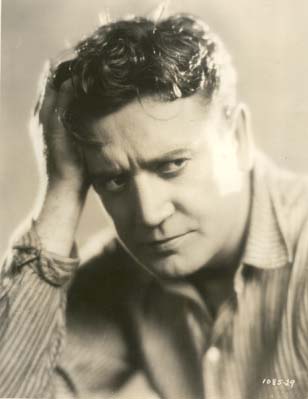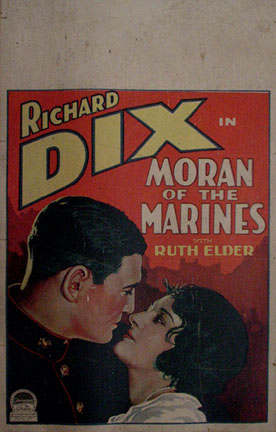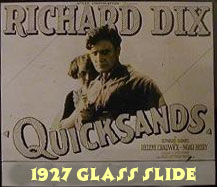of Richard Dix
To see images of vintage posters and to learn more about each movie click on the film title!
(1917)
One Of Many
(1921)
Not Guilty
(1922)
Fools First
(1921)
All's Fair In Love
Dangerous Curve Ahead
The Poverty Of Riches
(1922)
The Glorious Fool
The Wall Flower
Yellow Men and Gold
The Sin Flood
(1923)
Quicksands
(1923)
Racing Hearts
The Woman With Four Faces
(1924)
The Stranger
Icebound
Unguarded Woman
Sinners In Heaven
Manhattan
(1925)
A Man Must Live
Men And Women
Fascinating Youth
(1926)
Say It Again
(1927)
Paradise For Two
Knockout Reilly
Man Power
Shanghai Bound
The Gay Defender
(1928)
Sporting Goods
Easy Come, Easy Go
Warming Up
Moran Of The Marines
Please Help Support Film Preservation! Is it any wonder Richard Dix looks so concerned? This great portrait is from SHANGAI BOUND, one of 31 lost films from the Dix oeuvre. |
Of
by
Jere Guldin
First, the good news: All of Richard Dix's sound films survive. Although
many cannot be seen, or cannot be seen easily, at least they exist and
someday may become available. (The most rare title, NOTHING BUT THE TRUTH,
his first sound film, made for Paramount in 1929 and never released to
television, has been on current owner Universal's list to strike a new print
for the last several years.)
Now for the bad news.
Less than a third of all the silent films that starred Richard Dix are in
existence today. The rest have succumbed to decomposition (the
nitrocellulose--or nitrate--film stock on which motion pictures were printed
prior to 1951 deteriorates over time), vault fires (nitrate also happens to
be highly flammable), or willful destruction (once sound films supplanted
silents, the latter were thought no longer to have any commercial value, and
frequently were disposed of to cut down on overhead).
Of the forty-five silent features that Dix made, just fourteen are extant.
Not all of those that do survive are complete, either; several exist only in
shortened versions, or as single-reel (or less!) fragments. Gone entirely
are all of Dix's films from the years 1921, 1924, 1927, and 1928; his
pictures with top silent directors William De Mille, Mal St. Clair, Marshall
Neilan, Frank Lloyd, Sidney Franklin, and Herbert Brenon; and the majority
of his five collaborations with Gregory La Cava, director of MY MAN GODFREY
(1936), who made more movies with Dix than any other actor.
Given the opportunity, which "lost" Dix film would be the one most worth
recovering? If THE CHRISTIAN (1923 Goldwyn), THE TEN COMMANDMENTS (1923
Paramount) and THE VANISHING AMERICAN (1925 Paramount) did not exist
already, those would be the obvious choices. No other silent Dix features
had the same impact with audiences, or received the amount of critical
acclaim, as did these.
Excluding those titles, any silent movie fan's choice probably would be
influenced by that individual's own biases. Film professor and media
scholar Patrick Trimble picks WARMING UP due to the baseball angle (with
several of that era's ball-players appearing as themselves), although it
doesn't hurt that Jean Arthur, one of his favorite actresses, is featured,
or that long-time Harold Lloyd associate Fred Newmeyer directed. Historian,
author, and television personality Leonard Maltin opts forTHE GAY DEFENDER
because of the co-starring status of one of his favorites, Thelma Todd, plus
the involvement of Gregory La Cava and Herman Mankiewicz. Randy Haberkamp,
programmer at the Academy of Motion Picture Arts and Sciences and director
of The Silent Society, which regularly screens silent movies in Los Angeles,
chooses THE WOMAN WITH FOUR FACES for its director (Brenon made some of the
silent era's biggest pictures, including Beau Geste) cameraman (Wong Howe
was one of the greats, and not much of his work from the '20s survives), and
female lead (once a huge star, Betty Compson is little-known today).


A glass slide representing
the 1927 re-release of
Quicksands.
Note: The Paramount logo is no where to be found.
Several of Dix's pre-Paramount films make the cut among those polled, as
well. Academy archivist and long-time Richard Dix fan Sue Guldin goes for
his first picture, ONE OF MANY, and the opportunity to see the actor, albeit
in a minor role, six years younger than in any of his movies currently
available. Author and film historian Sam Gill speaks up for THE GLORIOUS
FOOL (with NOT GUILTY and THE STRANGER as runners-up), being intrigued by
its subject matter and having known pioneer director E. Mason Hopper during
his later years. The author of this article (Jere Guldin) chooses THE SIN FLOOD because
of its interesting storyline, and for its director, Frank Lloyd, usually a
sure bet for a good time at the movies. And Glenn Taranto, who maintains this website, would like to see QUICKSANDS , a picture with great credentials
that has a curious history due to its subesequent reissue after Dix had
become a major star (which in itself would make an interesting subject for a
future article here).
However fun such speculation may be, it is, unfortunately, only wishful
thinking. The chance of any of the lost films turning up is remote at best,
and Dix fans probably will have to content themselves with what is known to
survive . . . which isn't that much.
Jere Guldin is a Film Preservationist at the UCLA Film and Television
Archive.
(Special thanks to Richard Dix's #1 Fan, Sue Guldin, for loaning her collection to help fill in the gaps!)
The Lost films Of Richard Dix Copyright © 2001 Jere Guldin & exit82a
productions All Rights Reserved
Home
The Paramount Years - At RKO - The Other Studios
Cimarron
-The Whistler Series-